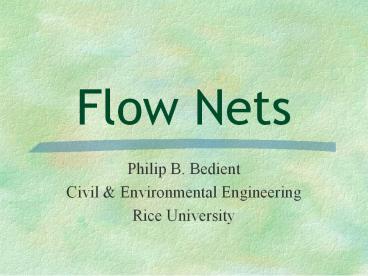Flow Nets - PowerPoint PPT Presentation
Title:
Flow Nets
Description:
... B. Bedient. Civil & Environmental Engineering. Rice University. 2. Flow Net ... If the permeable soil has a hydraulic conductivity of 150 ft/day, determine the ... – PowerPoint PPT presentation
Number of Views:2868
Avg rating:3.0/5.0
Title: Flow Nets
1
Flow Nets
- Philip B. Bedient
- Civil Environmental Engineering
- Rice University
2
Flow Net Theory
- Streamlines Y and Equip. lines ? are ?.
- Streamlines Y are parallel to no flow
boundaries. - Grids are curvilinear squares, where diagonals
cross at right angles. - Each stream tube carries the same flow.
3
Flow Net Theory
4
Flow Net in Isotropic Soil
- Portion of a flow net is shown below
Y
Stream tube
F
5
Flow Net in Isotropic Soil
- The equation for flow nets originates from
Darcys Law. - Flow Net solution is equivalent to solving the
governing equations of flow for a uniform
isotropic aquifer with well-defined boundary
conditions.
6
Flow Net in Isotropic Soil
- Flow through a channel between equipotential
lines ?1 and ?2 per unit width is ?q
K(dm x 1)(?h1/dl)
n
F1
F2
m
Dq
F3
Dh1
Dq
Dh2
dm
dl
7
Flow Net in Isotropic Soil
- Flow through equipotential lines 2 and 3
is ?q K(dm x 1)(?h2/dl) - The flow net has square grids, so the head drop
is the same in each potential drop ?h1 ?h2 - If there are nd such drops, then ?h
(H/n) where H is the total head loss between
the first and last equipotential lines.
8
Flow Net in Isotropic Soil
- Substitution yields
- ?q K(dm x dl)(H/n)
- This equation is for one flow channel. If there
are m such channels in the net, then total flow
per unit width is - q (m/n)K(dm/dl)H
9
Flow Net in Isotropic Soil
- Since the flow net is drawn with squares, then dm
? dl, and - q (m/n)KH L2T-1
- where
- q rate of flow or seepage per unit width
- m number of flow channels
- n number of equipotential drops
- h total head loss in flow system
- K hydraulic conductivity
10
Drawing Method
- 1. Draw to a convenient scale the cross sections
of the structure, water elevations, and aquifer
profiles. - 2. Establish boundary conditions and draw one or
two flow lines Y and equipotential lines F near
the boundaries.
11
Method
- 3. Sketch intermediate flow lines and
equipotential lines by smooth curves adhering to
right-angle intersections and square grids. Where
flow direction is a straight line, flow lines are
an equal distance apart and parallel. - 4. Continue sketching until a problem develops.
Each problem will indicate changes to be made in
the entire net. Successive trials will result in
a reasonably consistent flow net.
12
Method
- In most cases, 5 to 10 flow lines are usually
sufficient. Depending on the no. of flow lines
selected, the number of equipotential lines will
automatically be fixed by geometry and grid
layout. - 6. Equivalent to solving the governing
equations of GW flow in 2-dimensions.
13
Seepage Under Dams
Flow nets for seepage through earthen dams
Seepage under concrete dams Uses boundary
conditions (L R) Requires curvilinear square
grids for solution
14
Two Layer Flow System with Sand Below
Ku / Kl 1 / 50
15
Two Layer Flow System with Tight Silt Below
Flow nets for seepage from one side of a channel
through two different anisotropic two-layer
systems. (a) Ku / Kl 1/50. (b) Ku / Kl 50.
Source Todd Bear, 1961.
16
Effects of Boundary Condition on Shape of Flow
Nets
17
Radial Flow
Contour map of the piezometric surface near
Savannah, Georgia, 1957, showing closed contours
resulting from heavy local groundwater pumping
(after USGS Water-Supply Paper 1611).
18
Flow Net in a Corner
Streamlines Y are at right angles to
equipotential F lines
19
Flow Nets an example
- A dam is constructed on a permeable stratum
underlain by an impermeable rock. A row of sheet
pile is installed at the upstream face. If the
permeable soil has a hydraulic conductivity of
150 ft/day, determine the rate of flow or seepage
under the dam.
20
Flow Nets an example
The flow net is drawn with m 5 n 17
21
Flow Nets the solution
- Solve for the flow per unit width
- q (m/n) K h
- (5/17)(150)(35)
- 1544 ft3/day per ft
22
Flow Nets An Example
- There is an earthen dam 13 meters across and 7.5
meters high.The Impounded water is 6.2 meters
deep, while the tailwater is 2.2 meters deep. The
dam is 72 meters long. If the hydraulic
conductivity is 6.1 x 10-4 centimeter per second,
what is the seepage through the dam if n 21
K 6.1 x 10-4cm/sec - 0.527 m/day
23
Flow Nets the solution
- From the flow net, the total head loss, H, is
6.2 -2.2 4.0 meters. - There are 6 flow channels (m) and 21 head drops
along each flow path (n) Q (KmH/n) x dam
length (0.527 m/day x 6 x 4m / 21) x (dam
length) 0.60 m3/day per m of dam
- 43.4 m3/day for the entire 72-meter length
of the dam































